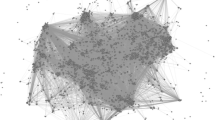Abstract
Most classic network entity sorting algorithms are implemented in a homogeneous network, and they are not applicable to a heterogeneous network. Registered patent history data denotes the innovations and the achievements in different research fields. In this paper, we present an iteration algorithm called inventor-ranking, to sort the influences of patent inventors in heterogeneous networks constructed based on their patent data. This approach is a flexible rule-based method, making full use of the features of network topology. We sort the inventors and patents by a set of rules, and the algorithm iterates continuously until it meets a certain convergence condition. We also give a detailed analysis of influential inventor’s interesting topics using a latent Dirichlet allocation (LDA) model. Compared with the traditional methods such as PageRank, our approach takes full advantage of the information in the heterogeneous network, including the relationship between inventors and the relationship between the inventor and the patent. Experimental results show that our method can effectively identify the inventors with high influence in patent data, and that it converges faster than PageRank.
Similar content being viewed by others
References
Ahmedi, L., Abazi-Bexheti, L., Kadriu, A., 2011. A uniform semantic web framework for co-authorship networks. IEEE 9th Int. Conf. on Dependable, Autonomic and Secure Computing, p.958-965. [doi:10.1109/DASC.2011.159]
Baglioni, M., Geraci, F., Pellegrini, M., et al., 2012. Fast exact computation of betweenness centrality in social networks. Proc. IEEE/ACM Int. Conf. on Advances in Social Networks Analysis and Mining, p.450-456. [doi:10.1109/ASONAM.2012.79]
Blei, D., 2012. Probabilistic topic models. Commun. ACM, 55(4):77–84. [doi:10.1145/2133806.2133826]
Blei, D.M., Ng, A.Y., Jordan, M.I., 2003. Latent Dirichlet allocation. J. Mach. Learn. Res., 3(3):993–1022.
Brin, S., Page, L., 1998. The anatomy of a large-scale hyper textual web search engine. Comput. Networks ISDN Syst., 30(1-7):107–117. [doi:10.1016/S0169-7552(98)00110-X]
Chiang, M.F., Liou, J.J., Wang, J.L., et al., 2012. Exploring heterogeneous information networks and random walk with restart for academic search. Knowl. Inform. Syst., 36(1):1–24. [doi:10.1007/s10115-012-0523-8]
Hirsch, J.E., 2005. An index to quantify an individual’s scientific research output. PNAS, 102(46):16569–16572. [doi:10.1073/pnas.0507655102]
Hofmann, T., 1999. Probabilistic latent semantic indexing. Proc. 22nd Annual Int. ACM SIGIR Conf. on Research and Development in Information Retrieval, p.50-57. [doi:10.1145/312624.312649]
Kleinberg, J.M., 1999. Authoritative sources in a hyperlinked environment. J. ACM, 46(5):604–632. [doi:10.1145/324133.324140]
Liu, X., Bollen, J., Nelson, M.L., et al., 2005. Co-authorship networks in the digital library research community. Inform. Process. Manag., 41(6):1462–1480. [doi:10.1016/j.ipm.2005.03.012]
Sun, Y., Han, J., 2012. Mining heterogeneous information networks: principles and methodologies. Synth. Lect. Data Min. Knowl. Disc., 3(2):46–89. [doi:10.2200/S00433ED1V01Y201207DMK005]
Sun, Y., Han, J., Zhao, P., et al., 2009. RankClus: integrating clustering with ranking for heterogeneous information network analysis. Proc. 12th Int. Conf. on Extending Database Technology: Advances in Database Technology, p.565-576. [doi:10.1145/1516360.1516426]
Tang, X.N., Yang, C.C., 2012. TUT: a statistical model for detecting trends, topics and user interests in social media. Proc. 21st ACM Int. Conf. on Information and Knowledge Management, p.972-981. [doi:10.1145/2396761.2396884]
Wang, X.H., Sun, J.T., Chen, Z., et al., 2006. Latent semantic analysis for multiple-type interrelated data objects. Proc. 29th Annual Int. ACM SIGIR Conf. on Research and Development in Information Retrieval, p.236-243. [doi:10.1145/1148170.1148214]
Zelikovitz, S., Hirsh, H., 2004. Using LSI for text classification in the presence of background text. Proc. 10th Int. Conf. on Information and Knowledge Management, p.113-118.
Zhang, J., Ma, X., Liu, W., et al., 2012. Inferring community members in social networks by closeness centrality examination. Proc. 9th Web Information Systems and Applications Conf., p.131-134. [doi:10.1109/WISA.2012.52]
Author information
Authors and Affiliations
Corresponding author
Additional information
Project supported by the National Science and Technology Support Plan (No. 2013BAH21B02-01), Beijing Natural Science Foundation (No. 4153058), and Shanghai Key Laboratory of Intelligent Information Processing (No. IIPL-2014-004)
Rights and permissions
About this article
Cite this article
Du, Yp., Yao, Cq. & Li, N. Using heterogeneous patent network features to rank and discover influential inventors. Frontiers Inf Technol Electronic Eng 16, 568–578 (2015). https://doi.org/10.1631/FITEE.1400394
Received:
Accepted:
Published:
Issue Date:
DOI: https://doi.org/10.1631/FITEE.1400394




